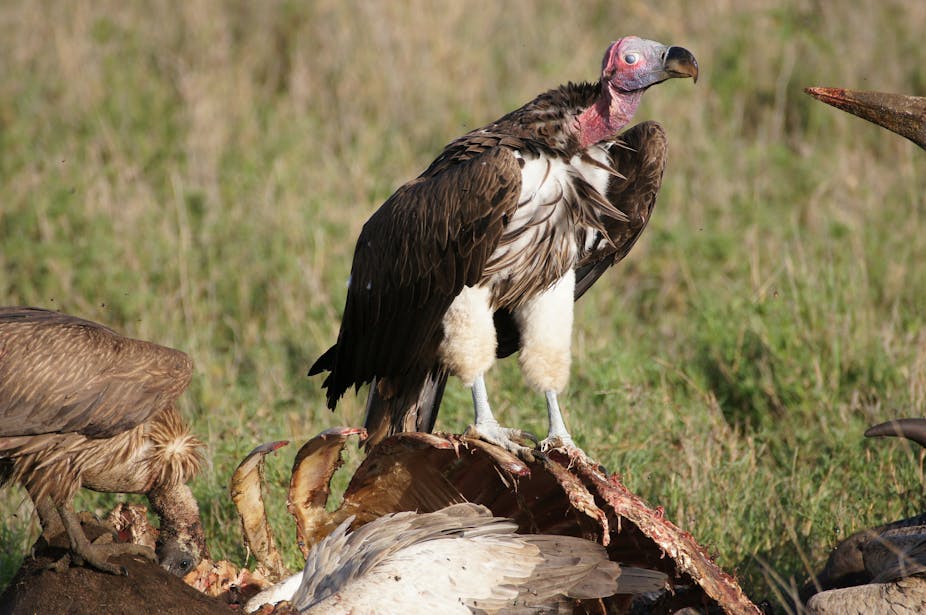Vultures are nature’s garbage disposers. They’re perfectly adapted to keep the environment clean and healthy by efficiently locating and consuming carcasses, recycling energy through the food web and preventing the spread of diseases. It’s an unpaid role. However it’s about time we did start repaying vultures for their services, by giving them the protection they deserve.
A new study published in the journal Genome Biology illustrates just how finely-tuned these birds are. The researchers perform a whole genome analysis of the Eurasian cinereous vulture (Aegypius monachus) and reveal a unique genetic make-up that explains vultures’ strongly acidic digestive system and their ability to resist infection from pathogens present in the rotting carcasses on which they feed.
It’s even possible vultures are able to exploit the flesh-eating properties of some bacteria to aid with the digestion of soft tissues and bones, while the secretion of corrosive gastric acids and specialised immune responses allow them to resist infection from, and potentially even destroy, highly infective pathogens such as anthrax and brucellosis.
This unusual tolerance of natural toxins doesn’t protect vultures from man-made contaminants however, which explains why 69% of vulture and condor species are listed as threatened or near-threatened, most of which are classed as “endangered” or “critically endangered”. The California condor (Gymnogyps californianus), for instance, was declared extinct in the wild in 1987 when the last remaining individuals were removed and placed in captivity to protect them from lead poisoning from ingesting shot and bullet fragments from hunted carcasses. Although captive-breeding and release programs have allowed the wild population to increase to more than 200 individuals, lead poisoning continues to cause fatalities.
Across Asia the big problem is accidental poisoning by diclofenac, an anti-inflammatory used to treat cattle. In vultures and some eagle species, tiny traces of the drug can lead to fatal kidney failure within 48 hours. In just 15 years, cow carcasses contaminated with diclofenac nearly wiped out three of Asia’s vulture species.

This had a big knock-on effect. With less competition at carcass disposal dumps, where people once let vultures pick dead animals clean, India’s feral dog population exploded. This caused higher rates of rabies transmission at an estimated additional cost of US$34 billion to the country’s healthcare between 1993 and 2006.
Although some populations have started to recover following the ban of diclofenac in India in 2006, a logic-defying 2013 approval to licence the drug for use in Europe now threatens vultures there too, particularly in Spain and Italy. In Spain, replacing the natural carcass disposal service provided by vultures with vehicle transport to processing plants would result in the equivalent of an additional 77,344 metric tons of CO2 being emitted to the atmosphere and US$50m of additional payments to insurance companies each year, according to a 2014 study in Nature.
Global decline
The situation in Africa is just as grim – “another continental vulture crisis”, as one group of researchers described it earlier this year. Populations of seven species have declined by more than 80% in three generations, giving rise to calls for six of those to be listed as “critically endangered”.
Once again man-made toxins and illegal activities are to blame. Poisoning accounts for 61% of vulture deaths, 29% are attributed to the trade in vulture heads and brains for local cultural beliefs# and 9% of fatalities are caused by electrocution or collision with power lines.
Widespread poisoning is certainly the most immediate threat. Usually this happens after farmers target lions, leopards or hyenas that have been attacking their livestock. Vultures consume the poisoned predators or the baited carcass itself and subsequently become secondary, inadvertent victims.
However the booming illegal trade in ivory and rhino horn is also bad news for them, as poachers don’t want hundreds of circling vultures pointing authorities towards recently-killed elephants or rhinos. Poachers are therefore deliberately targeting the birds by lacing carcasses with poisons – even after they’ve left with the tusks or horns. More than 500 vultures were poisoned at a single poached elephant carcass in Namibia in July 2013, and the recent discovery of at least 26 elephants poisoned at cyanide-laced water holes in Zimbabwe will also likely result in many vulture deaths.
Vultures need better PR
Why isn’t this a bigger scandal? After all, as many, if not more vultures are being killed in southern Africa each year as rhinos or elephants. Perhaps these big, bald, flesh-eating birds are perceived as sinister and lacking enough “cute factor”.
But while vultures don’t share the good looks of penguins or puffins, the ecosystem services they provide are irreplaceable. They compete with – and control – populations of blowfly larvae, rats, feral dogs and other scavengers, many of which are disease vectors. They ultimately make the world cleaner and healthier.
In fact, the ecological niche occupied by today’s vulture species is so specialised that two unrelated groups evolved on opposite sides of the world to become the primary scavengers in their ecosystems. “Old World” vultures from Eurasia and Africa and “New World” vultures and condors from the Americas might look and act the same but as the latest study highlights they don’t share a recent common ancestor, having diverged in evolutionary terms more than 60m years ago.

This is a classic example of “convergent evolution” – while Old World vultures share a common ancestry with eagles and New World species are more closely related to storks, they independently evolved similar specialisations to fulfil the important role of recycling carrion.
It’s time for us to appreciate these unique and highly-specialised birds. We must restrict harmful veterinary drugs, control illegal poisoning, provide uncontaminated sources of food and reduce the impact of power lines and wind farms. This must happen immediately to avoid a worldwide vulture crisis – and all of the negative implications for our own health and well-being.

